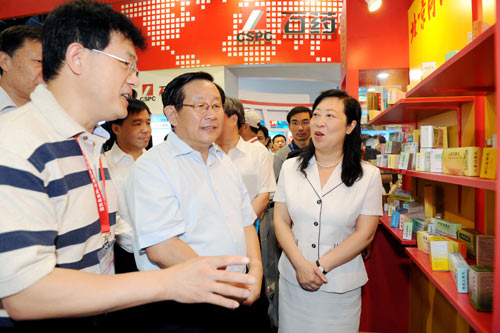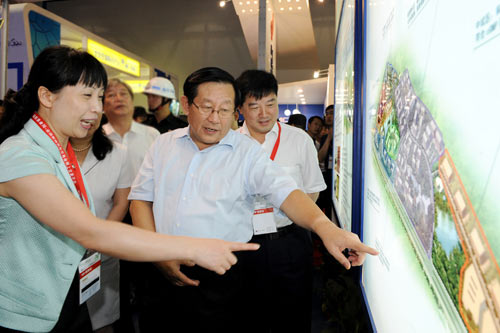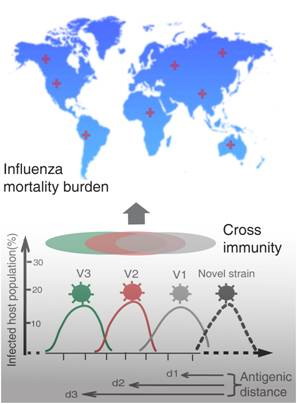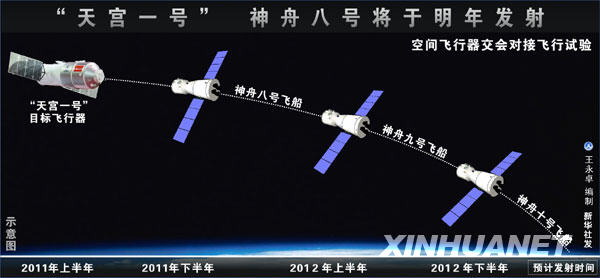|
CHINA SCIENCE AND TECHNOLOGY
NEWSLETTER
The Ministry of Science and Technology
People's Republic of China
|
|
|
N0.592 |
August 20, 2010 |
|
|
|
|
|
|
|
|
IN THIS ISSUE
|
|
*Health Summit and New Drug Show
*Shanghai be an Innovation Role Model
*Expression of Huntington in Pig Brains
* Rapid Estimation of Influenza Mortality Burden
*Tiangong I Getting Ready for Docking
* Strengthened Climate Change Studies
*Land Cover Database
|
Health Summit and New Drug Show



2nd Health Science and Technology Summit was held July 9-10, 2010 along with a new & special drug show at Beijing National Conference Center. SANG Guowei, Vice-Chairman of the NPC's Standing Committee, WAN Gang, Vice-Chairman of Chinese People’s Political Consultative Conference and Minister of Science and Technology, and other senior leaders were present at the event. WAN pointed out in his opening remarks that in the Outline of China’s Medium and Long Term S&T Development Planning (2006-2020), population and health topic was made a priority area. During the 11th Five-year Plan period (2006-2010), China has launched 16 earmark S&T projects, of which two were working on new drug development and infectious diseases prevention/control. During the period, the Ministry of Science and Technology has financed health related projects with a sum exceeding RMB 3 billion in the National 863 Program, and a sum up to 30% as of the total expenditures in the National 973 Program.
WAN proposed a range of strategies and measures to enhance S&T development in the area of health: 1) strengthen the planning efforts in the area of health science and technology, coordinating the use of resources in a unified manner, making the deployment as a whole, and supporting proprietary innovations and associated commercial applications; 2) implement new drug development and infectious diseases prevention/control earmark projects in a full-fledged manner, rolling out substantive and innovative new drugs; 3) strengthen health related R&D efforts, mastering key and core technologies, and enhancing the capacity building of emerging and strategic industries in the area; 4) encourage collaborations between government agencies and local government, developing biological and pharmaceutical industrial centers in the locality; 5) establish strategic alliances between industry, universities and research institutes in the area of biotechnology and pharmaceuticals, enhancing China’s international competitiveness in the area; and 6) strengthen personnel training and talents recruitment, fostering up a world class health science and technology contingent, and attracting internationally renowned academic leaders and innovation teams to work for China, taking advantage of the roles played by talents programs, including “thousand talents program”, and raising the innovation level of health S&T activities.
Shanghai be an Innovation Role Model
A range of government agencies, including Ministry of Science and Technology, Ministry of Finance, and Ministry of Education, have recently worked together to launch a nationwide campaign for technology innovations. Shanghai has been made an experimental site for the innovation initiative. By 2012, Shanghai is supposed to create a technology innovation system dominated by industry, and guided by the marketplace, taking advantage of the combined strength of industry, universities and research institutes, with a noticeably raised public awareness of innovation. As a result, Shanghai’s R&D expenditure will hit 3.0% as a proportion of its GDP, with an industrial R&D expenditure at 70%, substantive breakthroughs in key and core technologies, per million person/year invention patent grants reaching 245 in number, a proprietary technology possession rate at 32%, and accelerated commercial applications of new technologies. By that time, Shanghai’s major high tech industrial output will reach RMB 1.1 trillion, with a raised proportion of total industrial output up to 30%.
To achieve the aforesaid targets, Shanghai will strengthen the efforts in the following 9 areas, in line with national strategic missions and commercial applications of high technologies: 1) incubate more innovation enterprises. By 2012, innovation businesses in Shanghai shall reach 500 in number; 2) establish strategic alliances for technology innovation. By 2012, technology innovation alliances shall be established in 60 areas, including large airplane, semiconductor illumination, laser display, electronic tagging, next generation broadcasting and TV network, new energy, intelligent power grid, new energy autos, antibody drugs, medical instruments among many others; 3) establish and perfect industrial technology innovation service platforms. By 2012, 15 national and municipal service platforms will be established for industrial technology innovation activities, raising the efficiency of technology innovation; 4) strengthen the capacity building of technology innovation contingents; 5) establish an S&T banking system, allowing the banking industry to play a role in supporting innovation businesses; and 6) establish high tech industrialization bases and innovation parks, accelerating the construction of Zhangjiang Proprietary Innovation Demonstration Park, and Yangpu as an innovation district.
|
INTERNATIONAL COOPERATION |
Expression of Huntington in Pig Brains
LAI Liangxue, a research fellow at the CAS Guangzhou Institute of Biomedicine and Health, in collaboration with LI Xiaojiang, a researcher at Emory University, has successfully found the expression of Huntington's disease protein in apoptotic neurons in the brains of cloned transgenic pigs, making them have the typical symptoms of Huntington's disease. The finding was published in the August 8, 2010 issue of Human Molecular Genetics.
Using nuclear transfer, scientists generated transgenic Huntington's disease (HD) pigs that express mutant huntingtin with an expanded polyglutamine tract. Postnatal death, dyskinesia and chorea-like movement were observed in some transgenic pigs that express mutant huntingtin. Importantly, the transgenic HD pigs, unlike mice expressing the same transgene, displayed typical apoptotic neurons with DNA fragmentation in their brains. Also, expression of mutant huntingtin resulted in more neurons with activated caspase-3 in transgenic pig brains than that in transgenic mouse brains. The findings suggest that species differences determine neuropathology, and underscore the importance of large mammalian animals for modeling neurological disorders.
Deer Genome Sequencing
Not long ago, the Institute of Special Products, part of the Chinese Academy of Agricultural Sciences, launched a project to sequence the full genome of Chinese sika deer. Scientists from China, New Zealand, and Canada, will sequence, assemble, and interpret the genome of Chinese sika deer using the new generation high flux sequencing technique (shotgun method). The effort will create a ground for scientists to study functional genomics, proteomics, and molecular genetic breeding of Chinese sika deer, making the species the first member of the deer family having a fully sequenced genome in the world. Once having the DNA map, scientists will be able to speed up the breeding process of Chinese sika deer, sorting out reproduction capability related SNP marks and functional genes, especially the one that regulates the reproduction of pilose antler.
Rapid Estimation of Influenza Mortality Burden

New model for influenza mortality burden.
A study team, led by JIANG Taijiao at the Institute of Biophysics, part of the Chinese Academy of Sciences, has recently developed a new model to show the interactions between the hosts and strains (the chart). The finding, published in the August 12, 2010 online issue of PLoS Computational Biology, has resulted in establishing a quantitative tie between mortality burden and variants, and working out a technique to rapidly estimate the influenza mortality burden.
By proposing a novel host-virus interaction model, researchers have established a positive correlation between the excess mortalities caused by viral strains of distinct antigenicity and their antigenic distances to their previous strains for each type of seasonal influenza viruses. Based on this relationship, researchers further developed a method to rapidly assess the mortality burden of influenza A virus by accurately predicting the antigenic distance between A (H1N1) strains. The finding makes a useful tool for health authorities to formulate a cost-effective response for influenza control and prevention. The study was financed by a major national earmark project for infectious diseases, and by the National 973 Program.
Robot Working in Deep Wells
Thanks to 7-year painstaking efforts, Chinese engineers made a successful test on August 18, 2010 to the robot they have developed in an underground rocky layer with an elevation of 2,000m in Jinping, Sichuan Province. According to a briefing, the cylinder shaped robot is made up of a ‘brain’, body, and a range of gadgets. The ‘brain’ is the ground control system, displaying and controlling the robot’s activities underground.
The monitor shows every detail of the robot’s activities at an underground level 2,000m above sea level. The robot was lowered down to a preset depth, before letting it get settled, cleaning the rock surface, making the surface dry, smoothed, and glued for stress tests, using the gadgets it was equipped with. The ground control system received the first batch of data in half an hour, marking the success of the test. The robot can be employed to analyze the stability of earth crusts and geological formation, or make a geological analysis for water reservoirs and dams, in addition to the utility for geological disasters (earthquake and mudslides) prediction and prevention.
Enhanced Reflective Tape for Highway
Sinotape International has recently rolled out a high performance reflective tape for highway applications. Made of synthesized rubber and resin, the novel reflective tape enjoys numerous merits, including fine adaptability, easy installation, enhanced reflectivity, long service life, and self-cleaning. Able to reflect traffic lights passed by in a striking manner, it can be employed to be traffic marks, symbols, and signs.
The novel reflection tape is designed with unique concavo-convex patterns and tiny glass balls with enhanced light reflectivity on the surface, evenly attached to an inner layer made up of synthesized resin, color, and additives, which allows a stable light reflectivity even when the surface is worn off. The unique concavo-convex pattern design ensures the best possible safety, as the pattern would produce noise and vibrations for warning when pressed by wheels. The new product offers a long lasting coating performance, and an enhanced reflectivity, compared with the old road reflection system.
Tiangong I Getting Ready for Docking

China’s manned space project spokesman said on August 17, 2010 that Chinese engineers have finished the assembly of Tiangong I (a palace in the heaven), a target spacecraft that will be employed to perform docking missions. The target spacecraft has moved into a comprehensive test phase to see its electric, dynamic, and thermal performance. It will be launched in 2011, before getting docked with the Shenzhou 8 capsule.
According to a briefing, a range of systems to be employed in the docking missions, including the target spacecraft, enhanced CZ2-F launch vehicle, and improved manned Shenzhou capsule, have finished their respective prototype development and tests, moved on to the official development phase. Up to date, all the systems have been developed in a smooth manner. The Shenzhou 8 capsule is being assembled. The enhanced CZ2-F launch vehicle has entered the phase of sub-system tests. Meanwhile, astronauts training was kicked off in a full-fledged manner, with the participation of two women astronauts. The payloads to be aboard the target spacecraft and Shenzhou 8 capsule have been delivered on schedule for installation. The ground control and support systems have also been geared to get prepared for the mission.
Strengthened Climate Change Studies
Ocean-atmosphere processes over the Southern Ocean and Indian Ocean and their impacts on climate change in East Asia and in the globe, a major national global change study, was kicked off on August 13, 2010 in Qingdao. The project is designed to study Asian monsoon systems that affect the climates in China, in an attempt to understand the break-up, development, and interannual variation of Asian monsoons from the angle of ocean-atmosphere interactions, raising China’s short range climate prediction, and disasters prevention/ preparedness capability. Researchers will enhance field observations along the sections from the Southern Ocean to the Indian Ocean, and further to East Asia, working on theoretical studies and climate prediction modeling. They will also study the major mechanisms through which the ocean-atmosphere processes over the Southern Ocean and the Indian Ocean affect the floods and long term climate change in China, improving the dynamic and statistic part of short range climate prediction models, and raising the accuracy of predictions.
Land Cover Database
China’s Land Cover and Associated Remote Sensing, a book jointly compiled by a number of research institutes, including CAS Institute of Remote Sensing Application, was recently published by Star Map Press. With the support of an initiative to built a network to share earth data, the Chinese Academy of Sciences launched a nationwide land cover remote sensing survey to map out the dynamic and systematic evolutions of land cover across China’s territorial land and offshore islands at a scale of 1 to 250,000, running from the 1980s to 2005. China’s Land Cover and Associated Remote Sensing is the result of the joint survey efforts.
Largest DMTO Unit into Operation
Not long ago, an industrial Methanol-to-Olefins unit with a capacity of producing 600,000 tons of olefins a year, the largest of its kind in the world, was put into operation. The unit, applied with the DMTO technology originally developed by Chinese Academy of Sciences Dalian Institute of Chemical Physics, and perfected by the industrial tests made by SYN Energy Technology and China Petrochemical Corporation Luoyang Branch, is a proprietary industrial system able to turn methanol into olefins. The developers signed in September 2007 a technology application permit with Shenhua Group, allowing it to build a unit with the technology in September 2008. The unit was completed of construction in May 2010.
Comments or inquiries on editorial matters or Newsletter content should be directed to:
Department of International Cooperation, MOST 15B, Fuxing Road, Beijing 100862, PR China Tel: (8610)58881360 Fax: (8610) 58881364
http://www.most.gov.cn |

